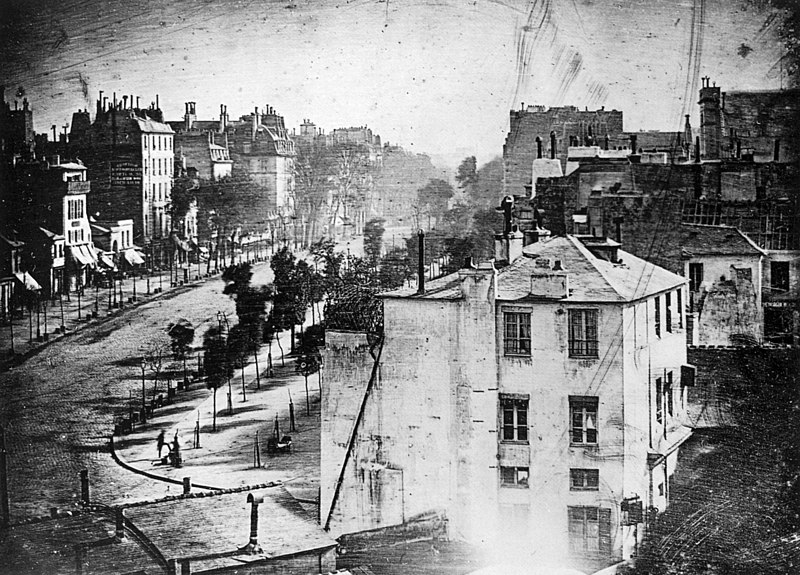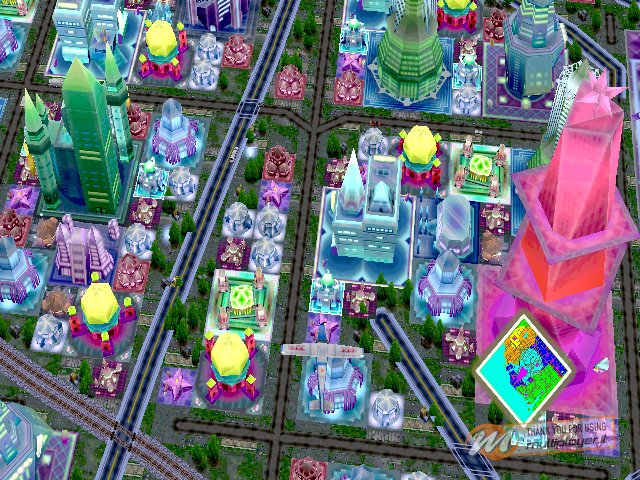THE IDEAL CITY FROM PLATO TO SimCity
We are multi-level. Artists, philosophers and scientists have always known it.
We surf the Internet acknowledging the existence of a platonic second navigation, of an Aristotelic level jump from potentiality to actuality, to the different angelic hierarchies or Dante's Infernal circles, stricken both by Bruno's heroic frenzy and Leibniz's binary arithmetic. We tear up the veils of Maya with deep pleasure and no shame: we leave the same traces as Derrida. We are made of the same substance as a Flemish oil, and of the same powerful inconsistency as a film by Kulešov. Behind the ideal city of the Renaissance we see Daguerre's Paris appear into light, and the 1889 World's Fair, with the Eiffel Tower, photographed from bird's-eye view on Google Earth. Let's play SimCity.
We surf the Internet acknowledging the existence of a platonic second navigation, of an Aristotelic level jump from potentiality to actuality, to the different angelic hierarchies or Dante's Infernal circles, stricken both by Bruno's heroic frenzy and Leibniz's binary arithmetic. We tear up the veils of Maya with deep pleasure and no shame: we leave the same traces as Derrida. We are made of the same substance as a Flemish oil, and of the same powerful inconsistency as a film by Kulešov. Behind the ideal city of the Renaissance we see Daguerre's Paris appear into light, and the 1889 World's Fair, with the Eiffel Tower, photographed from bird's-eye view on Google Earth. Let's play SimCity.
Francesco di Giorgio Martini, Città ideale (1477), Berlino, Gemaldegalerie
The daydream of an ideal city and a society in harmony with both nature and its own tools of survival is an integral part of the destiny men chose for themselves: that of being “social animals” (Aristotle again) and therefore dedicated to finding a reality superior to their plain and simple needs (Plato, patriarch of all modern concepts of “artificial reality” and of all levels of representation, from video games to Photoshop, that ultimately relate to the lines of thought elaborated in his tradition).

And since we are talking about Neo-Platonists, let’s start from humanism and from those true icons of the new Republic created by an anonymous artist, perhaps Piero della Francesca in the two painting of the Ideal City (we can pick the most famous one, or the Baltimore Panel, or both, which constitute a very determined dyad). And let’s not forget the coeval urban view by Francesco di Giorgio Martini, with the grid-effect given by the columns that makes it look like a screenshot from SimCity (it is possible to neo-ludically transport it in time next to Will Wright’s video game).

Moving on, from painting to a visionary etching by Piranesi who also addresses sculpture and architecture by presenting us with a Roman Via Appia which, though it never actually existed, is filled with echoes from Antiquity (the weight of heritage is overwhelming if not scientifically analyzed in all its components).

Next stops, Daguerre’s photographic reproduction of the present, obtained by framing the Boulevard du Temple in Paris, and Fritz Lang’s less-than-ideal but not completely unlikely Metropolis – better if re-staged with man-sized technicians and without the actors’ heavy make-up – walking through Antonio Sant'Elia's unrealized projects (a chance to mention Futurism and its self-proclaimed mixture of art and technology, leaving out its “hygienic war”: past, present and future are all fine with us who are connecting them). Finally, we get to Sim City and its stadium, or a soccer field where Pelé, Maradona and Roberto Baggio foul less than anyone else.

Buckminster Fuller, PadiglioneUSA a Expo 67, Terre des Hommes, Ile Sainte-Héléne, Montréal, Canada (foto di Cédric Thévenet)
Landing place and GAME ON, in this amorous multi-level, will be a kind of humanism that will not be standardized, but rather deeply rooted in history, and therefore able to question itself, also by knowingly interacting with its own technological reproductions. This way, we will try to prevent hasty jumps into a shallow “post-human” (which not only smells musty, but feels like a lack of responsibility) or into a generic nostalgia for God knows what legendary eras (the territory of snobbish and mediocre people, which is the same).
Every interaction is an interpretation that calls for our presence.
The effects of this new social network, based on a true “ecology of the other,” will not be limited to art – such tight categories are overdue – but, in a scientific and yet passionate fashion, they will help increase and improve the meaning of words like “nature,” “development” and “society,” laying the foundations for progress, and not just a virtual one.
With that in mind, art comes into play.
in

Will Wright, SimCity, 1989
Il sogno ad occhi aperti di una città ideale e
di una società in armonia tanto con la natura quanto con i propri strumenti del
vivere è parte integrante del destino scelto dall’uomo in quanto “animale
sociale” (ancora Aristotele) e in quanto dedito alla ricerca di una realtà
superiore rispetto ai bisogni primari puri e semplici (Platone, patriarca di
tutte le moderne idee di “realtà artificiale” e di tutti i livelli, tanto dei
videogiochi quanto di Photoshop, che in ultima istanza si rifanno alle
elaborazioni di pensiero della sua scuola).

E visto che parliamo di neoplatonici, partiamo proprio dall’umanesimo e da quelle vere e proprie icone della nuova Repubblica che sono i due dipinti di anonimo, forse Piero della Francesca, della Città ideale (si può scegliere il più famoso o quello conservato a Baltimora o tutti e due per una bella diade non più indeterminata). Senza dimenticare la visione di città del coevo Francesco di Giorgio Martini, con quell’incasellamento dato dalle colonne che sembra un riquadro di SimCity (volendo si può neoludicamente trascinarla nel tempo accanto al videogioco di Will Wright). Poi, dalla pittura a un’incisione visionaria di Piranesi che ci parla anche di scultura e architettura evocando una Via Appia romana mai esistita ma quanto mai ricca dei più svariati echi dell’età antica (il peso delle eredità è sovrabbondante quando non ancora analizzato in modo scientifico fra le sue componenti).

Per approdare quindi alla riproduzione fotografica del presente operata da Daguerre, inquadrando il Boulevard du Temple parigino, e alla forse non ideale ma sempre futuribile Metropolis di Fritz Lang - meglio se in allestimento con i tecnici a misura d’uomo e senza il pesante trucco degli attori - passando per i progetti mai realizzati dal nostro Antonio Sant’Elia (così abbiamo anche il rimando al futurismo e alla sua conclamata commistione fra arte e tecnologia, non certo alla sua “guerra igienica”: siamo in pace con passato, presente e futuro noi, che li connettiamo).

Concludendo proprio con SimCity e il suo stadio di football o un campo di calcio dove Pelè, Maradona e Roberto Baggio giocano facendo meno falli di tutti.


E visto che parliamo di neoplatonici, partiamo proprio dall’umanesimo e da quelle vere e proprie icone della nuova Repubblica che sono i due dipinti di anonimo, forse Piero della Francesca, della Città ideale (si può scegliere il più famoso o quello conservato a Baltimora o tutti e due per una bella diade non più indeterminata). Senza dimenticare la visione di città del coevo Francesco di Giorgio Martini, con quell’incasellamento dato dalle colonne che sembra un riquadro di SimCity (volendo si può neoludicamente trascinarla nel tempo accanto al videogioco di Will Wright). Poi, dalla pittura a un’incisione visionaria di Piranesi che ci parla anche di scultura e architettura evocando una Via Appia romana mai esistita ma quanto mai ricca dei più svariati echi dell’età antica (il peso delle eredità è sovrabbondante quando non ancora analizzato in modo scientifico fra le sue componenti).

Foto da Archives New Zealand
Per approdare quindi alla riproduzione fotografica del presente operata da Daguerre, inquadrando il Boulevard du Temple parigino, e alla forse non ideale ma sempre futuribile Metropolis di Fritz Lang - meglio se in allestimento con i tecnici a misura d’uomo e senza il pesante trucco degli attori - passando per i progetti mai realizzati dal nostro Antonio Sant’Elia (così abbiamo anche il rimando al futurismo e alla sua conclamata commistione fra arte e tecnologia, non certo alla sua “guerra igienica”: siamo in pace con passato, presente e futuro noi, che li connettiamo).

Concludendo proprio con SimCity e il suo stadio di football o un campo di calcio dove Pelè, Maradona e Roberto Baggio giocano facendo meno falli di tutti.

Approdo e nuovo GAME ON di questo
multilevel amoroso sarà una forma di umanesimo non standardizzata ma figlia di
un profondo radicamento storico e quindi capace di rimettersi continuamente in discussione,
interagendo in maniera consapevole anche con le sue riproduzioni tecnologiche.
In questo modo si cercherà di evitare frettolosi salti in un “post human”
superficiale (che, oltre a puzzare di vecchio, sa tanto di mancata assunzione
di responsabilità) o in nostalgie interessate di chissà quali ere mitiche
(privilegio di snob e mediocri, cioè della stessa cosa).
Ogni interazione un’interpretazione
da condivenire.


Rilievi da Escher, Den Haag
Gli effetti di questo nuovo
network sociale, che fa sua una vera e propria “ecologia dell’altro”, non si
limiteranno solo all’arte – i compartimenti stagni sono arrugginiti – ma
contribuiranno a definire in modo scientifico e appassionato un ampliamento
quantitativo e qualitativo di senso di termini come “natura”, “sviluppo” e
“società”, ponendo le basi per un progresso non solo virtuale.
L’arte si mette in gioco per
questo.



Nessun commento:
Posta un commento